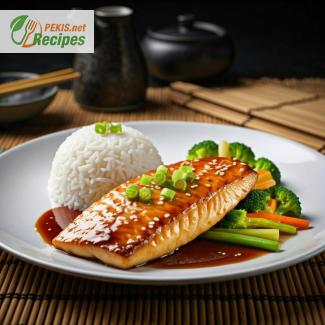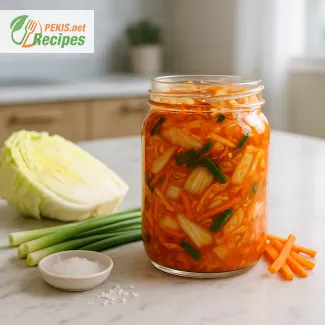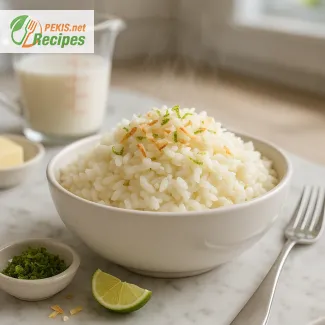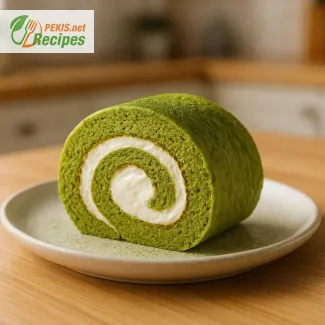
Discover the Art of Preparing Classic Teriyaki Amberjack at Home. If you’re a fan of savory-sweet flavors and perfectly glazed fish, then this Classic Teriyaki Amberjack recipe is the ultimate dish to master in your kitchen. Amberjack, with its firm texture and rich taste, is the perfect fish for absorbing the bold flavors of teriyaki sauce. This recipe brings together a harmonious balance of umami, sweetness, and delicate fish, making it a restaurant-quality meal you can prepare at home.
The Essence of Teriyaki Cuisine
Teriyaki is a timeless Japanese cooking technique that highlights the beauty of simplicity. By using a combination of soy sauce, mirin, sake, and sugar, it creates a deeply flavorful glaze that enhances the natural qualities of the main ingredient. The word "teriyaki" itself refers to the shine or gloss of the sauce, a key characteristic achieved through careful cooking. When paired with amberjack, this dish transforms into an unforgettable culinary experience that celebrates the art of Japanese cooking.
Why Amberjack Is the Perfect Choice
Amberjack, known as "kanpachi" in Japanese cuisine, is a prized fish due to its firm yet tender flesh and mild, buttery flavor. Its texture makes it ideal for marinating and grilling, as it absorbs marinades well while retaining its structure during cooking. When coated in teriyaki sauce, the amberjack becomes a luscious, flavorful centerpiece that pairs beautifully with steamed rice or fresh vegetables.
A Dish for All Occasions
Whether you’re preparing a quick weeknight dinner or a show-stopping dish for a special occasion, Teriyaki Amberjack is versatile and easy to adapt. The preparation process is simple, yet the result is undeniably impressive. Each bite bursts with the distinctive flavors of soy, sweetness from sugar, and the subtle tang of mirin, leaving you and your guests wanting more.
Health Benefits of Teriyaki Amberjack
Not only is this dish delicious, but it’s also packed with nutritional benefits. Amberjack is a great source of:
- Proteins, which support muscle repair and growth.
- Omega-3 fatty acids, promoting heart and brain health.
- Vitamin D, essential for bone strength and immune support.
The teriyaki glaze, while indulgent, can be adjusted to include less sugar or sodium for a health-conscious twist, without sacrificing its signature flavor.
What Makes Homemade Teriyaki Special
Making teriyaki sauce from scratch allows you to tailor the flavor to your liking. By controlling the ingredients, you ensure a fresh and authentic taste that store-bought sauces can’t replicate. The combination of just a few pantry staples—soy sauce, mirin, sake, and sugar—transforms into a glossy, flavorful coating that enhances the natural umami of amberjack.
Tips for Perfecting Your Teriyaki Amberjack
- Marination is Key: Allow the fish to marinate for at least 30 minutes to absorb the flavors deeply.
- Control the Heat: Cook the amberjack over medium heat to prevent burning the delicate teriyaki sauce.
- Baste Generously: Continuously brush the fish with the sauce during cooking to achieve the signature glossy finish.
- Balance the Sides: Serve with light accompaniments like steamed rice, sautéed greens, or pickled vegetables to complement the bold flavors.
A Culinary Experience Worth Sharing
There’s something incredibly satisfying about recreating a dish that rivals your favorite Japanese restaurant. This Classic Teriyaki Amberjack recipe is more than just a meal; it’s an opportunity to bring authentic Japanese flavors into your home. The combination of succulent fish, aromatic sauce, and fresh sides makes this dish a true standout that will impress your family and friends.
Embrace the simplicity and elegance of Japanese cooking with this recipe, and let the flavors of teriyaki transport you to the heart of Japan’s rich culinary heritage. Whether you’re a seasoned chef or new to the kitchen, this dish is your gateway to mastering a timeless classic.
- Prepare the sauce: In a small bowl, combine soy sauce, mirin, sake, and sugar. Stir until the sugar dissolves completely.
- Marinate the fish: Place the amberjack fillets in a shallow dish and pour half of the teriyaki sauce over them. Let the fish marinate for 20–30 minutes, turning occasionally to ensure even absorption.
- Heat the pan: In a large non-stick skillet, heat vegetable oil over medium heat.
- Cook the fish: Remove the fillets from the marinade, allowing any excess sauce to drip off. Place the fillets in the pan and cook for 3–4 minutes on each side, until golden brown. Remove the fillets and set them aside.
- Simmer the sauce: Pour the remaining teriyaki sauce and the marinade into the same pan. Bring it to a boil, then reduce the heat and let it simmer for 2–3 minutes, until the sauce thickens slightly.
- Glaze the fish: Return the amberjack fillets to the pan and spoon the thickened sauce over them. Let the fish cook for another 2 minutes, ensuring they are well coated in the glossy glaze.
- Serve: Arrange the fillets on plates and drizzle with any remaining sauce. Garnish with sesame seeds and chopped spring onion, if desired. Serve immediately with steamed rice and sautéed vegetables.
Tips and Variations to Enhance Classic Teriyaki Amberjack
Creating Classic Teriyaki Amberjack at home is an exciting culinary adventure, and with a few adjustments, you can tailor the dish to your taste, dietary needs, or available ingredients. Below are detailed tips and recommendations for how you can adapt and refine this recipe while maintaining its balance of flavors and textures.
Substitutions for Ingredients
Soy Sauce Alternatives
- Low-Sodium Soy Sauce: Using a low-sodium option reduces the salt content without significantly altering the flavor. This is ideal for those watching their sodium intake while preserving the dish’s umami profile.
- Tamari (Gluten-Free): Tamari is a gluten-free substitute that has a slightly richer taste. It’s perfect for maintaining the classic teriyaki flavor while catering to gluten-sensitive diets.
- Coconut Aminos: For a soy-free option, coconut aminos provide a mildly sweet and savory taste, though slightly less salty. This substitution creates a lighter, more delicate teriyaki sauce.
Sweetness Adjustments
- Honey or Maple Syrup: Replace sugar with honey or maple syrup for a natural sweetness. Honey provides a floral, rich depth, while maple syrup adds an earthy, caramel-like flavor. These changes make the dish more aromatic and slightly softer in sweetness.
- Brown Sugar: Switching to brown sugar enhances the teriyaki sauce with a deeper, molasses-like flavor, giving the glaze a darker, richer tone.
Mirin and Sake Options
- Rice Vinegar and Sugar: If you don’t have mirin, mix rice vinegar with sugar in a 2:1 ratio to replicate its sweetness and tang.
- Non-Alcoholic Substitutes: For a non-alcoholic version, use apple juice or white grape juice combined with a splash of vinegar to mimic the acidity and sweetness of sake and mirin.
Fish Variations
- Salmon: Substituting amberjack with salmon results in a buttery, melt-in-your-mouth dish with a slightly oilier texture. The natural richness of salmon pairs wonderfully with the teriyaki glaze.
- Cod or Haddock: For a milder flavor, use white fish like cod or haddock. These fish absorb the teriyaki sauce well and create a softer, more delicate dish.
- Tofu or Chicken: If you prefer a non-fish option, firm tofu or boneless chicken thighs are excellent alternatives. Tofu creates a vegetarian-friendly version with a soft texture, while chicken delivers a heartier, meatier bite.
Enhancements to the Flavor Profile
Add Fresh Ginger or Garlic
- Finely grated ginger or minced garlic can be added to the teriyaki sauce for a spicier and more aromatic kick. These ingredients complement the savory and sweet notes, creating a more dynamic flavor profile.
Spice It Up
- For those who enjoy heat, add a pinch of red pepper flakes or a drizzle of chili oil to the sauce. The subtle spiciness contrasts beautifully with the sweetness of the glaze.
Citrus Zest
- Adding a sprinkle of orange or lemon zest to the finished dish enhances its brightness and adds a refreshing tang, balancing the richness of the sauce and fish.
Textural Adjustments
Crispy Skin
- If your amberjack has skin, crisp it up by cooking the fillet skin-side down first in a hot pan without flipping for the first few minutes. This adds a delightful crunch to each bite, providing textural contrast.
Toasted Sesame Seeds
- Toasting the sesame seeds before garnishing intensifies their nutty flavor and enhances the overall aroma of the dish.
Accompaniment Modifications
Side Dishes for Balance
- Quinoa or Brown Rice: For a healthier alternative to white rice, serve the amberjack with quinoa or brown rice. Both options offer more fiber and a nuttier flavor that complements the teriyaki glaze.
- Roasted Vegetables: Swap sautéed vegetables for roasted options like Brussels sprouts, sweet potatoes, or zucchini for a smoky and caramelized side.
- Japanese Pickles: Adding pickled radishes or cucumbers brings a tangy, refreshing element that cuts through the sweetness of the sauce.
Technique Tips for Enhanced Results
Marination Time
- For a more intense flavor, extend the marination time to 1–2 hours. This allows the amberjack to fully absorb the teriyaki sauce, resulting in a richer taste with each bite.
Layered Glaze Application
- To achieve a deeply glossy glaze, baste the fish multiple times with the teriyaki sauce during cooking. This creates a thicker, more flavorful coating that adheres beautifully to the fish.
Pan-Seared vs. Grilled
- While pan-searing the fish is traditional, grilling the amberjack adds a smoky depth of flavor that pairs wonderfully with the sweetness of the glaze. Use a grill pan for indoor cooking or an outdoor grill for a charred finish.
Balancing Nutrition and Flavor
Reducing Sugar
- Lower the sugar content in the sauce by half and add a touch of honey or stevia for sweetness. This modification maintains flavor while reducing calories and sugar levels.
Low-Fat Cooking
- Use a non-stick pan to minimize the need for oil, or opt for a light cooking spray. This adjustment lowers the fat content while ensuring the fish cooks evenly.
Boosting Antioxidants
- Incorporate antioxidant-rich garnishes like shredded red cabbage or a small side of edamame. These additions increase the nutritional value of the dish without altering its flavor.
This recipe for Classic Teriyaki Amberjack is as versatile as it is delicious. By experimenting with substitutions, enhancements, and techniques, you can personalize the dish to suit your preferences or dietary needs. Whether you make small changes, like swapping soy sauce for tamari, or bigger ones, like replacing amberjack with tofu or chicken, these adjustments can transform the dish while keeping its core essence intact. Embrace these tips and enjoy creating your version of this timeless classic!
Contains soy (soy sauce), alcohol (mirin, sake), and fish (amberjack).
Substitution Tips:
- For a gluten-free option, replace soy sauce with tamari or gluten-free soy sauce.
- Use a non-alcoholic mirin substitute by combining water and sugar (2 parts water to 1 part sugar).
- Replace amberjack with salmon or cod for a different fish option.
- Vitamin B12: Supports nerve function and red blood cell formation.
- Vitamin D: Strengthens bones and boosts the immune system.
- Selenium: Acts as a powerful antioxidant and supports thyroid health.
- Potassium: Aids in maintaining normal blood pressure and muscle function.
- Selenium (30 mcg): Neutralizes free radicals and reduces oxidative stress.
- Vitamin E (1 mg): Promotes healthy skin and protects against cell damage.
Enjoy this elegant and flavorful dish, perfect for elevating your home dining experience!





